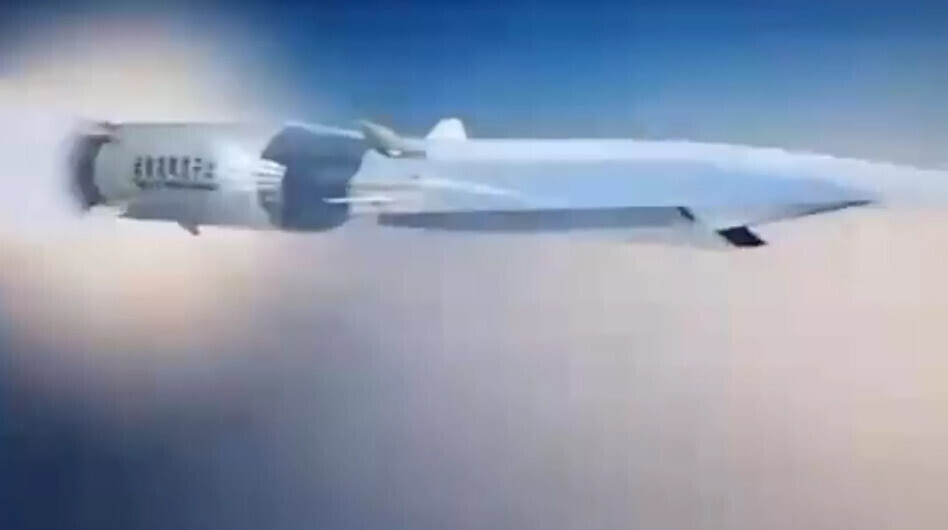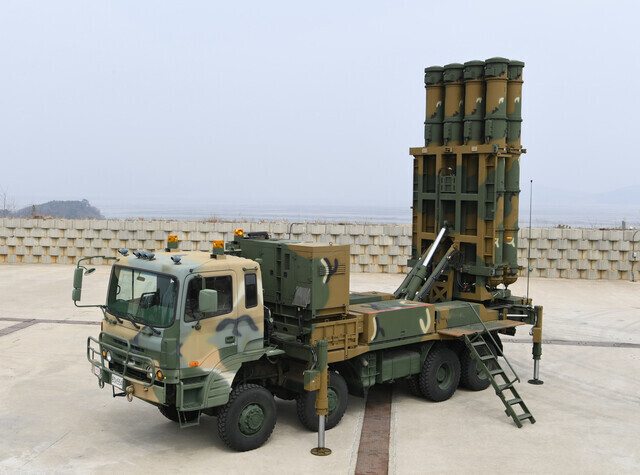hankyoreh
Links to other country sites 다른 나라 사이트 링크
Hype or reality? A closer look at the science of N. Korea’s hypersonic missile and the threat it poses

After North Korea launched a hypersonic ballistic missile on Jan. 14, a veritable wealth of articles with click-bait headlines highlighting that a hypersonic missile launched by the North could make its way to Seoul in a minute flat flooded the internet.
The articles claimed that since hypersonic missiles exceed Mach 5 — five times the speed of sound — a missile of that speed launched from Pyongyang would reach Seoul in around a minute, and its fast speed would make it virtually impossible to intercept.
Mach 1 refers to the speed of sound (340 meters per second). Projectiles with a flight speed between Mach 1 and Mach 5 are classified as supersonic, and anything over Mach 5 is labeled hypersonic. At Mach 5 or higher, a missile would be able to traverse the 195 kilometers (121 miles) between Pyongyang and Seoul in one to two minutes.

However, it would be a stretch to say that such a missile would render South Korea’s missile system useless.
Hypersonic missiles share similar speeds and flight times with conventional ballistic missiles of the same range, debunking the claim that hypersonic missiles are more difficult to counter with conventional air defense systems because of their speeds.
Intercontinental ballistic missiles (ICBMs), for example, reach speeds around Mach 20, and short-range missiles also fly at speeds between Mach 4 and Mach 7, with most exceeding Mach 5. The South Korean military’s Hyunmoo ballistic missile series can reach speeds well over Mach 5. In terms of speed, almost all ballistic missiles are hypersonic.
As such, ballistic missiles are classified according to range, not speed: short-range ballistic missiles (SRBMs) travel 300 to 1,000 kilometers, medium-range ballistic missiles (MRBMs) fly between 1,000 and 3,000 kilometers, intermediate-range ballistic missiles (IRBMs) have ranges between 3,000 and 5,500 kilometers, and ICBMs fly for 5,500 kilometers or more.
The most important characteristic of hypersonic missiles is not their speed, but their ability to glide unpowered to low altitudes during their terminal flight phase. Hypersonic missiles combine the best features of conventional ballistic and cruise missiles.
Ballistic missiles, which use rocket propellants, have high speeds and heavy warheads that are capable of mass destruction. Like a rock thrown from the shore, a ballistic missile follows a parabolic flight trajectory in multiple phases: boost, post-boost, midcourse and terminal.

If a ballistic missile’s flight trajectory is detected and tracked early in its launch, it is easy to predict its impact point and launch site. Predicting the missile’s impact point is necessary to assign the optimal interceptor to engage with the missile, and predicting the launch point is necessary to identify and strike the point of origin.
Cruise missiles, however, are powered by jet engines, allowing them to fly at the same low altitudes as airliners. The low altitude allows them to slip under enemy radar and precisely attack key targets like command centers and military facilities.
The disadvantage is that the majority of them travel under the speed of sound — slow for missiles. They can also be observed from land, making them susceptible to antiaircraft weapons and fighter jets. The US-developed Tomahawk missile travels at 880 km per hour. Standard airliners travel at speeds between 700 and 800 km per hour.
While ballistic missiles are categorized according to distance, cruise missiles are categorized according to speed. Anything under Mach 1 is a subsonic missile (for example, the Tomahawk). Missiles that travel at speeds between Mach 1 and Mach 5 are supersonic. Missiles that travel at speeds over Mach 5 are hypersonic. The faster a missile is, the more difficult it is to intercept.

Hypersonic missiles are divided into hypersonic glide vehicles (HGV), which are propelled by rocket boosters similar to the ones installed on ballistic missiles, and hypersonic cruise missiles (HCM), which utilize airbreathing jet engines. HCMs require more complex technology.
The hypersonic ballistic missile that North Korea launched on Jan. 14 falls into the category of an HGV. This type of missile rises in elevation to exit the atmosphere before diving back into the atmosphere into a “gliding” trajectory. It poses the biggest threat when it travels at speeds of Mach 5 or faster. Because North Korea does not have the technology to build hypersonic cruise missiles, it appears to be attempting to utilize hypersonic ballistic missiles as a stepping stone.
North Korea’s hypersonic ballistic missile was propelled by the same rocket boosters as the standard ballistic missiles. Despite it being a ballistic missile, domestic media coverage focused on the missile’s speed, effectively treating it like a cruise missile. The key detail was a Mach 5 speed that could theoretically send a missile from Pyongyang to Seoul within one minute.

There are four stages to the flight of a hypersonic ballistic missile. Stage 1: The glider separates from the rocket propeller to rise and then drop in elevation. Stage 2: Once it enters the upper layers of the atmosphere, the missile slows its speed and enters a stable gliding phase. Stage 3: The missile glides to its target. Stage 4: The missile drops toward its target. The missile’s differentiating attributes pertain to its ability to “glide” in the atmosphere during Stages 2 to 4, whether it’s vertically or horizontally, without an engine propelling it.
Perhaps the biggest advantage of a hypersonic missile is its unconventional maneuverability. Like a standard ballistic missile, a hypersonic ballistic missile exits the atmosphere and then drops in elevation to re-enter the atmosphere. At this point, it differs from a standard ballistic missile, as a hypersonic missile can change its elevation and direction of flight multiple times at a low altitude. Even at this point, the missile maintains a speed of Mach 5 or faster, making it difficult for the enemy to counter. During a Senate Armed Services hearing in March 2018, John Hyten, the former commander of the US Strategic Command, admitted that there is no real defense against a hypersonic missile. This is why hypersonic missiles are often referred to as “game changers” that could alter the course of a war.
If that’s the case, if North Korea integrated hypersonic ballistic missiles into its repertoire, would they render South Korea’s missile defense systems useless? Not likely. While hypersonic missiles are difficult to counter using conventional missile defense systems, intercepting or disrupting them is not impossible.
During Stage 1, a hypersonic ballistic missile’s flight path is similar to that of a standard ballistic missile. A hypersonic missile’s range is around 1,000 km, compared to a ballistic missile’s 600 km. South Korea has a Green Pine radar system installed at a high altitude (ground-based, early warning system for ballistic weapons, capable of detecting within a range of 800 km). The country’s Navy has a SPY-1 radar on its Aegis-equipped destroyers. The Air Force’s E-737s have an airborne early warning radar.
Detecting the initial flight of a hypersonic missile is not much different from detecting that of a ballistic missile. Hypersonic missiles produce aerodynamic heating during their glide phases, resulting in surface temperatures between 1,000 and 2,000 degrees. Utilizing infrared sensors would enable a detection system.
During Stage 4 of a hypersonic missile’s flight, it drops in elevation, producing drag and reducing its velocity. Consequently, despite its speed during other stages of flight, a hypersonic missile travels at similar speeds to ballistic missiles when approaching its target. The proper systems could therefore enable interception. In this way, a hypersonic missile’s de facto speed is not astronomically faster than that of a ballistic missile. And the longer a hypersonic missile spends in the atmosphere, the more its velocity decreases. This opens up possibilities for a feasible defense system.

Some observers are concerned about North Korea’s hypersonic weapons rendering South Korea’s “kill chain” system powerless. The kill chain is designed to neutralize a missile before it’s launched. The system relies on early detection of command, launch, and support systems for enemy missiles. After mobile launch pads or other targets are identified, the system activates to eliminate a missile when it detects a clear intention to strike. Because the system eliminates a missile threat before its launch, it doesn’t matter whether the missile is hypersonic or not.
Cho Hong-il, a researcher at the Korean Institute for Defense Analyses, offered the following analysis in August 2022: “While some people are describing hypersonic missiles as ‘invincible,’ with no tenable defense against them, it’s essential that we re-evaluate our view of them as simply the next technological stage of ballistic missiles. We need to change the way we look at them if we’re going to develop the proper defense concepts and systems.”
By Kwon Hyuk-chul, staff reporter
Please direct questions or comments to [english@hani.co.kr]

Editorial・opinion
![[Guest essay] Preventing Korean Peninsula from becoming front line of new cold war [Guest essay] Preventing Korean Peninsula from becoming front line of new cold war](https://flexible.img.hani.co.kr/flexible/normal/500/300/imgdb/original/2024/0507/7217150679227807.jpg) [Guest essay] Preventing Korean Peninsula from becoming front line of new cold war
[Guest essay] Preventing Korean Peninsula from becoming front line of new cold war![[Column] The state is back — but is it in business? [Column] The state is back — but is it in business?](https://flexible.img.hani.co.kr/flexible/normal/500/300/imgdb/original/2024/0506/8217149564092725.jpg) [Column] The state is back — but is it in business?
[Column] The state is back — but is it in business?- [Column] Life on our Trisolaris
- [Editorial] Penalties for airing allegations against Korea’s first lady endanger free press
- [Editorial] Yoon must halt procurement of SM-3 interceptor missiles
- [Guest essay] Maybe Korea’s rapid population decline is an opportunity, not a crisis
- [Column] Can Yoon steer diplomacy with Russia, China back on track?
- [Column] Season 2 of special prosecutor probe may be coming to Korea soon
- [Column] Park Geun-hye déjà vu in Yoon Suk-yeol
- [Editorial] New weight of N. Korea’s nuclear threats makes dialogue all the more urgent
Most viewed articles
- 1Behind-the-times gender change regulations leave trans Koreans in the lurch
- 2South Korean ambassador attends Putin’s inauguration as US and others boycott
- 3Yoon’s revival of civil affairs senior secretary criticized as shield against judicial scrutiny
- 4Family that exposed military cover-up of loved one’s death reflect on Marine’s death
- 5Hybe-Ador dispute shines light on pervasive issues behind K-pop’s tidy facade
- 6Japan says its directives were aimed at increasing Line’s security, not pushing Naver buyout
- 7[Editorial] New weight of N. Korea’s nuclear threats makes dialogue all the more urgent
- 8[Guest essay] Preventing Korean Peninsula from becoming front line of new cold war
- 9Yoon’s broken-compass diplomacy is steering Korea into serving US, Japanese interests
- 10U.S. band that performed in N. Korea looking forward to going back